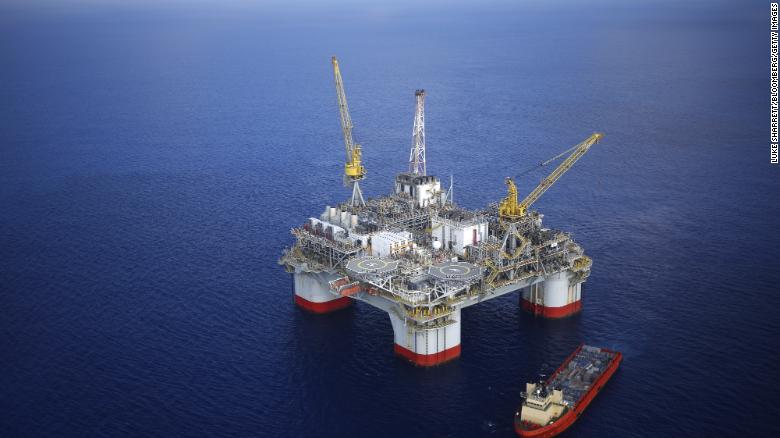On The Horns of an Energy Dilemma
"I don't think people know that we have this ocean in the United States that's filled with industry."
Scott Eustis, ecologist, Gulf Restoration Network
"We were flying to monitor the BP disaster and we kept seeing these slicks, but they were nowhere near the BP spill."
"There is no requirement under law of the United States that actually the agencies or the industry put you on notice of a continuing spill."
"And so what happened is you have an offshore area that is not actually seen by most people unless you're flying over it, and most organizations can't afford to fly over it."
"It just went under the radar until there was a need to fly over, which was the BP disaster, when people started noticing that there was something wrong."
"When they asked the federal government, the federal government admitted, 'Yeah, there's a problem'."
Cynthia Sarthou, executive director, Gulf Restoration Network
 |
| Oil sheen is seen with vessels assisting in the Gulf of Mexico near the source of the BP Deepwater Horizon in 2010. Conservationists have discovered another little-known oil spill by Taylor Energy that is still leaking and may be even worse. (Mario Tama/Getty Images) |
"There is abundant evidence that supports the fact that these reports from NRC [U.S. Coast Guard National Response Center] are incorrect."
"My conclusion is that NRC reports are not reliable."
U.S.Justice Department-sponsored independent analysis, Oscar Garcia-Pineda, geoscience consultant
There is an estimated two thousand oil rig platforms in the waters off Louisiana, with another two thousand off the neighbouring coasts of Texas and Mississippi. Added to those rigs pumping up oil the Gulf of Mexico, rich with oil and gas regions proving to be the most productive in the world, hosts close to 80,000 km of active and inactive pipelines to carry oil and minerals to shore. An average of 20 uncontrolled releases of oil (blowouts) occur every year for every thousand wells in state and federal waters. What's more, hundreds of workers are injured every year.
In 2004 an oil-producing platform attached to 28 wells sank when Hurricane Ivan triggered a mudslide. Most of those wells have since been spewing oil, though the owner, Taylor Energy, managed to successfully cap some of them. Now, an estimated 30 to 700 barrels of oil daily, have been pouring into the Gulf, a phenomenon that seems to be inured to any easy fix, and one that may simply go on forever. As disastrous as the infamous BP Deepwater Horizon spill was, this one may overtake it in infamy.
There is a forest of oil platforms springing up from the waters of the Gulf. Where the Taylor platform once stood a colourful slick of oil is visible for kilometres. Where Taylor Energy declared just a few barrels-worth of oil was escaping daily, the reality is far, far beyond that. Offshore platforms in general off the Louisiana coast see on average 330,000 gallons of crude spilled daily, figures supplied by a state agency monitoring those spills.
But the Gulf, representing one of the world's richest and most productive oil and gas fields in the world yielded over 600 million barrels this year alone representing close to 20 percent of total U.S. production, with another 40 billion barrels underground, to be recovered as time goes on, according to government analysts. On the negative side, aside from uncontrolled releases, fire erupts offshore every three days on average, aside from the casualty numbers of injured workers.
The sunken Taylor platform stood in over 250 metres of water, about 40 stories in height, legs pile-driven into the ocean floor comprised of mud. Funnels were attached to its 28 drilled oil wells and at its peak Taylor Energy was a thriving enterprise. That ended abruptly when Hurricane Ivan struck and toppled the platform when 230 km/h winds and 20 metre waves roared into the Gulf and underwater, dislodged tons of mud, buckling the platform.
The resulting mud avalanche knocked the sunken platform "170 metres downslope of its original location" as over 620 barrels of crude stacked on its deck tumbled along with it into the ocean and a jumble of steel and leaking oil became buried in 50 metres of mud. Taylor Energy hired contractors to locate the wells under the fortress of impenetrable mud and debris, to cap them, even as they were unable to drill or bore through the muck lest their activity strike a pipe or well and release even greater volumes of oil.
A fortune was spent by Taylor Energy to pull the deck of the platform out of the ocean and plug a third of the wells, then build a type of shield to keep the crude from rising. In short, they pulled off a seemingly impossible feat, yet without solving the problem of the remaining two-thirds of the leaking wells -- and the oil kept leaking. Taylor was arguing the leak was no more than two gallons daily even while the Coast Guard estimated 784 gallons or more leaking from 16 wells.
A decade on, the actual level of oil leaking into the Gulf is up to 700 barrels each day; a barrel containing the equivalent of 42 gallons.
 |
| A deepwater oil platform in the Gulf of Mexico off the coast of Louisiana. |
Labels: Gas, Gulf of Mexico, Oil, Spills, United States

<< Home